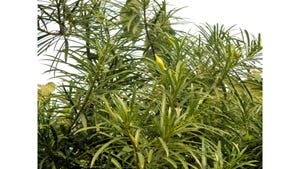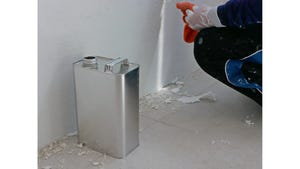Getting Valid Information from Process Safety Data
March 4, 2016

By Dr. Stephen Rowe, Dekra Insight
Having a process safety data parameter does not mean you have the information needed for safe design. For example, in the field of chemical reaction hazards, the most staggering example of lack of understanding of what is required to make a process safe is encapsulated the following, regularly asked, question:
“We have a reaction with a heat of reaction of -100 kJ/mol; can you please conduct the vent sizing calculations?”
What is missing here is the understanding that -100 kJ/mol explains the thermodynamic property of the reaction, but not the kinetic property (ie. how big is the exothermic reaction, but not how fast it is). The dimensioning of a relief device or safety valve is based on the kinetic properties (rate of gas or vapor generation) which will vary depending on the scenario. The scenario(s) which may be applicable to the reaction are determined by feeding the thermodynamic data in to a risk assessment, identifying potential loss of control scenarios and their causes, and then simulating them (in a suitable adiabatic calorimeter) to determine the rapidity of the reaction under the failure condition. Only then do we have the information needed to answer the vent sizing question.
Learn More about Process Safety at the International Powder & Bulk Solids Conference & Exhibition, May 3-5, 2016
Although the immortal declaration of Thomas Jefferson stated “All men are created equal,” the same is unfortunately not true of process safety data. For any given parameter, there are often a bewildering range of test standards, commercial equipment and modes of operation which further complicate the challenge of getting the right data from the right test. Sometimes, the differences in test methods between standards are relatively minimal. However, in other tests, the differences can have a serious impact on the data obtained and the decisions that are made based on the data. Some examples of differing protocols for individual properties include:
* Minimum Ignition Energy (MIE) of a dust cloud. Possible causes of variation in data:
o Range of standard methods – IEC 61241-2-3, EN 13821, ASTM E2019, etc.
o Range of commercial equipment – MIKE III (Kuhner), MIE III (Chilworth), etc.
o Optional inductance – two methods exist:
* Low inductance method – suitable for electrostatic spark simulation and electrostatic hazard assessment
* High inductance method – suitable for mechanical spark simulation – produces longer duration sparks and hence generally gives much lower MIE values
o Impact of sample preparation – particle size and moisture content of tested material
* Finer particles generally produce lower MIE values
* Drier material generally produces lower MIE values
o Impact of temperature – increase in temperature significantly reduces the MIE of a powder. The impact can span orders of magnitude over modest temperature ranges.
* Flash Point of a liquid
o Range of standard methods and several in each – EN, ISO, ASTM, etc.
o Range of commercial equipment – Pensky-Martens, Able, Cleveland, Setaflash, etc.
o Various configurations – open cup/closed cup, flame ignition, hot coil ignition
o Various procedures - Equilibrium/non-equilibrium
* Thermal Stability of a Powder. Wide ranges of:
o Test methods – DSC, DTA (Carius Tube, TSu, RSD, Radex, etc.), Diffusion cell, Aerated cell, air over layer, adiabatic calorimeters, Thermal Activity Monitors (TAMs)
o Operating conditions – ramped (range of rates), isothermal, stepped
o Air availability – important for powder drying scenarios
o Sample sizes used in the commercial equipment – from mg to kg – significant impact on sensitivity
o Safety margins required for scale-up – from directly scalable to requiring up to 100°C safety margin for scale-up
These nuances in tests methods, equipment, and test conditions are common to almost all process safety properties. So we arrive at the conclusion that obtaining the correct data for the appropriate property is pivotal in providing the necessary data applicable for the intended purpose. Defining the test method and test conditions requires full consideration of the intended application of the test data. The selection process requires an intimate understanding of the impact of the variables and identifying which combinations of conditions will provide the most applicable data. The quality of test data obtained by an operating company thus becomes strongly linked to the depth of knowledge of staff who are specifying the test requirements and test conditions.
Testing protocols have to be intelligently specified to provide the correct data for the scenario/purpose. Even once the data is available it remains critical to understand its applicability to avoid applying the data to inappropriate situations.
In some circumstances, “standard data” may not adequately characterize the required properties and recognizing this requires knowledge of test method applicability – again, back to competence. Examples of where standard tests may not suffice:
* High pressure and/or temperature operating conditions
* Unique operating conditions
* Simulation of incident scenarios
It is also the case that for some properties, discrete testing programs can offer considerable cost efficiency – without compromising effectiveness. For minimum ignition energy, for example, an organization may have reviewed potential ignition sources and confirmed that all electrostatic ignition sources above a certain threshold have been removed via a combination of procedural and engineering controls. Conducting a full MIE determination may therefore not be necessary – a simple “go/no-go” boundary test may adequately advise the suitability of the material for the specific plant.
Used intelligently, some process safety data can be applied to numerous scenarios thereby providing cost effectiveness as well as improved efficiency in data collection. Safety and optimization/rationalization are therefore not necessarily mutually exclusive. Thermal stability data collected using DSC, for example can be used for:
* Process Safety
• Onset temperature of undesirable reactions (corrected for applicable safety margin or scale factor)
• Magnitude of undesirable events
• Potential explosivity of process materials or mixtures
* Transportation/Regulatory Safety (e.g. UN/REACH/US DOT)
• UN Class 1 exemption if heat of decomposition is less than 600 J/g
• UN Class 4.1 exemption if heat of decomposition is less than 300 J/g and/or if decomposition onset temperature is significantly above 75°C (cut-off for self-reactive substance classification)
• REACH explosives risk phrase exemption, melting point, boiling point, morphology investigation
Reaction calorimetry data can similarly be used for:
* Process Safety
• Confirming heat of reaction, adiabatic temperature rise, kinetics and gas generation characteristics of the normal (controlled) chemical process.
* Process Optimization
• Optimizing a process by examining mechanisms to reduce reagent accumulation. Such changes can significantly improve process efficiency in large scale production by reducing cycle times and optimizing solvent levels (as a balance between safety (solvent provides heat sink to avoid high adiabatic temperature rise) and green chemistry (reducing waste and impacting process intensity))
Ultimately, the objective of any laboratory testing is to obtain appropriate information necessary for ensuring the safety of our operations to protect our people, assets and the environment – therein protecting the organization itself. The translation of data to information is therefore as critical as the validity of the data itself. What matters is that we understand what it takes to create a process safety risk (i.e. make a dust cloud explode or a reaction runaway) and to ensure that we have preventive strategies in place to mitigate the risk or protective strategies in place to mitigate the consequences.
Conclusion
To get meaningful information we must handle the complexity of determining the correct parameters to study, with the correct test procedure to derive said data, and with a need to adequately and correctly interpret and apply the data to the plant environment. Without a universally prescriptive and accepted procedure, it is clear to see the challenge that process safety data presents to ensuring safe operations – and why so many organizations’ best efforts are compromised in this area.
Dr. Stephen Rowe manages the activities in the UK of Dekra Insight Process Safety (Chilworth Technology Ltd). He has a career background in the assessment of chemical reaction hazards and the laboratory assessment of a full range of process safety hazards including dust, gas, and vapor flammability and explosives characterization. He is an experienced trainer and regular contributor to national and international process safety conferences and symposia.
For related articles, news, and equipment reviews, visit our Instrumentation & Control Equipment Zone
Click here for a List of Instrumentation & Control Equipment Manufacturers
You May Also Like

